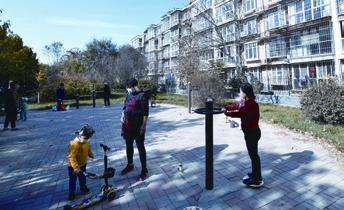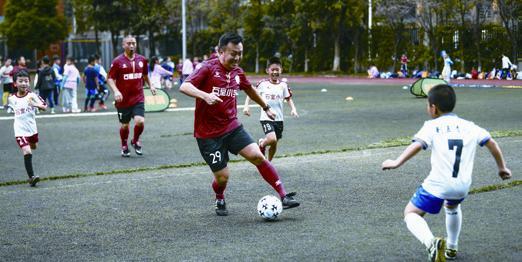A Bigger Playground
By Lu Yan


In the past, football fan Zhang Chengyuan had to cycle quite a distance to the nearest football field from his home. But since the construction of a football field in his neighborhood in Chaoyang District in Beijing three years ago, it takes him only 10 minutes to go kick a ball around.
This football field used to be undeveloped land littered with the neighborhoods waste. “Every time I walked past this area before the renovation, I just couldnt stand the sight of it and would walk faster, whereas now it has become one of my favorite places in the community,” Zhang told China Sports Daily.
In 2017, a local sports bureau, the subdistrict office and a property developer joined forces to add free sports and recreational facilities for residents including the football field, a basketball court, several table tennis rooms, as well as chess and card rooms.
In recent years, China has been promoting a nationwide fitness campaign and building sports facilities. “Building sports facilities in residential areas ensures that residents can do sports without having to travel far, thus they are willing and glad to build up their strength,” Li Jianming, Deputy Director of the General Administration of Sport of China (GASC), said at a press conference in October. “The campaign aims to promote peoples health and enrich their lives.”
Policy push
To enhance peoples fitness and health and boost the development of the sports industry, China has implemented a number of policies, especially in the recent five years.In July 2016, the GASC published the 13th Five-Year Plan for the sports industry. The plan sets the goal to increase the number of people regularly doing physical exercises to 435 million and the value added of Chinas sports industry to 1 percent of GDP by 2020.
The National Fitness Program (2016-20) and the Healthy China Outline (2030) were also issued that year. These documents encourage people to incorporate regular physical activities into their routines. They also call for the construction of public sports facilities convenient for people to use.
Issued one year after Beijing won the bid for hosting the 2022 Olympic Winter Games, some documents promote winter sports on a large scale and the construction of such facilities.
In August 2019, the State Council released the Outline for Building a Leading Sports Nation, which set the goal to develop China into a strong sports country by the year 2050.
Nowadays, people in China engage in a wide range of physical exercises. Some 35 percent of the population took part in sports regularly, wrote Gou Zhongwen, head of the GASC, in an article published in 2019. That percentage translates to 4.7 million people, exceeding the target set in the 13th FiveYear Plan on the sports industry.
In the outline issued in 2019, the government set the goal to raise regular public participation in sports to above 45 percent by 2035 and have 92 percent of the people meet the national physical fitness standards by then.
Not only the sports and health authorities but also education authorities are urging people to engage in physical exercises. In a bid to promote students health and encourage them to strengthen their body, the Education Department of Yunnan Province in southwest China issued a plan in October to raise the full score in physical education in the senior high school entrance examination from 50 to 100 points, equal to that of major subjects such as Chinese, mathematics and English.
In the past, when the high school entrance examination was looming, it was common practice for a number of schools to cancel their physical education classes for students to take classes in the three major subjects instead.
Zhang Chunhua, Deputy Director of the Yunnan Provincial Department of Education, said the provinces decision addresses the fact that an increasing number of students today suffer from shortsightedness, obesity and other physical and mental health issues, as a result of heavy school workloads.
“The purpose of the reform is to boost the students well-rounded development and alleviate their coursework pressure,” Zhang Chunhua said. The reform will be launched from this fall semester.
Liu Xinping, the mother of a middle school student in Shenyang, Liaoning Province in northeast China, likes the idea of more sports for students. “My son will not only become healthier through doing sports, but also grow his teamwork ability through group games like football or basketball. Its like killing two birds with one stone,” Liu told Beijing Review.
As more people get into sports, more sports facilities are needed. In 2016, the National Development and Reform Commission and the GASC released a plan on popularizing public sports, which stated that the sports facilities available were not in line with peoples demand.
The plan set specific targets to resolve these problems. For instance, it stated that by 2020, the per-capita sports area should reach 1.8 square meters. The coverage rate of primary-level sports and fitness facilities should be increased. There should be half of a football field per 10,000 people. Old residential areas must renovate and construct small venues and facilities that can support single or multiple fitness activities such as ball games, martial arts, gymnastics and swimming.
Such reforms are funded by the Central Government, the Public Welfare Fund of China Sports Lottery, local government funds plus donations from individuals, enterprises and other social forces.
And progress is well underway. Over 5,700 projects subsidized by the Central Government have been carried out. Many old factory buildings, warehouses and unused land are being transformed into sports areas. For example, in Haizhu District in Guangzhou, capital city of Guangdong Province in south China, a piece of unused land gave way to an indoor swimming pool. The number of sports fields increased from 4,982 in 1949 to about 3.1 million in 2019, Gou said.
Booming industry
In 2015, together with his friends, Luo Da, a postgraduate student majoring in sociology at Beijing Sport University, started a WeChat account that posted news and other information about the sports industry. In five years, their WeChat platform has grown into a startup company called Ecosports which provides sports media and industry services and has an annual revenue of more than 10 million yuan($1.5 million).“The sports industry is a sunrise industry, and as part of the industry, I have a sense of mission for its future development,” Luo told Xinhua News Agency.
A document issued in 2014 by the State Council to develop the sports industry and promote sports consumption, also known as the No.46 Document, set the industry onto a fast track. The momentum has continued into the 13th Five-Year Plan (2016-20) period.
Liu Fumin, Director of the Department of Sports Economics of the GASC, said that during the 13th Five-Year Plan period, the growth rate of the value added of the sports industry is much higher than that of the GDP. “This shows a huge market potential and room for development,” he said.
From 2015 to 2018, the value added of the sports service industry increased by 34.2 percent on average annually. Liu said a variety of new businesses are emerging, such as sports tourism, sports culture and creativity, sports advertising, sports media and sports exhibitions.
Large sports venues have sprouted up to meet the needs of the booming industry. The government encourages opening such venues to the public at low or no cost, and will improve subsidy policies to that end.
This is stated in a document released by the State Council this October, with opinions on strengthening the construction of fitness facilities and promoting sports for all.
Li said the utilization of large sports venues should be maximized when theres no large competition taking place. Nationwide community-based sports events and activities are encouraged to be held in such venues or small and medium-sized local venues. “Such events and activities are more inclusive in terms of participants and the range of sports,” Li said.
“In its 14th Five-Year Plan (2021-25) period, China will further push forward the optimization and upgrading of the sports industrial structure, and encourage innovation, making sports a pillar industry of the national economy,” Liu said. In October, the GASC announced that 1,000 sports-themed parks will be built in the next five years.

